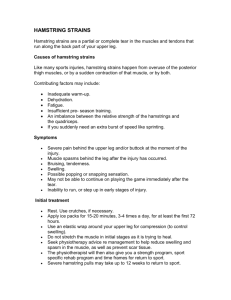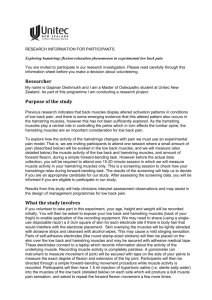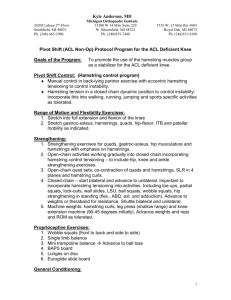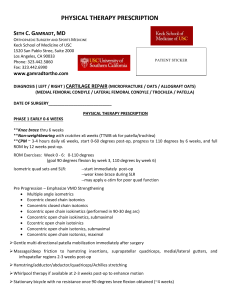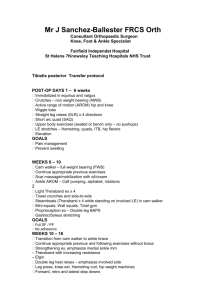What Causes a Hamstring Strain?
advertisement
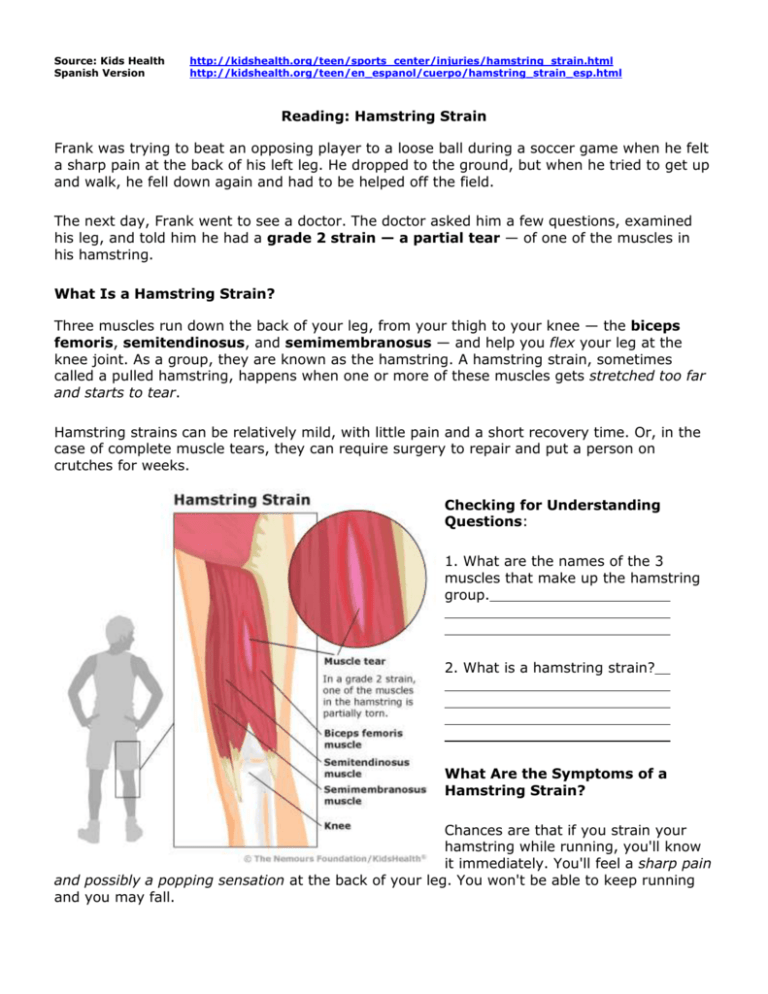
Source: Kids Health Spanish Version http://kidshealth.org/teen/sports_center/injuries/hamstring_strain.html http://kidshealth.org/teen/en_espanol/cuerpo/hamstring_strain_esp.html Reading: Hamstring Strain Frank was trying to beat an opposing player to a loose ball during a soccer game when he felt a sharp pain at the back of his left leg. He dropped to the ground, but when he tried to get up and walk, he fell down again and had to be helped off the field. The next day, Frank went to see a doctor. The doctor asked him a few questions, examined his leg, and told him he had a grade 2 strain — a partial tear — of one of the muscles in his hamstring. What Is a Hamstring Strain? Three muscles run down the back of your leg, from your thigh to your knee — the biceps femoris, semitendinosus, and semimembranosus — and help you flex your leg at the knee joint. As a group, they are known as the hamstring. A hamstring strain, sometimes called a pulled hamstring, happens when one or more of these muscles gets stretched too far and starts to tear. Hamstring strains can be relatively mild, with little pain and a short recovery time. Or, in the case of complete muscle tears, they can require surgery to repair and put a person on crutches for weeks. Checking for Understanding Questions: 1. What are the names of the 3 muscles that make up the hamstring group. 2. What is a hamstring strain? What Are the Symptoms of a Hamstring Strain? Chances are that if you strain your hamstring while running, you'll know it immediately. You'll feel a sharp pain and possibly a popping sensation at the back of your leg. You won't be able to keep running and you may fall. Other symptoms of a hamstring strain include: pain in the back of your thigh when you flex or extend your leg tenderness, swelling, and bruising in the affected area weakness in your leg that lasts for a long time after the injury In the event of a particularly severe strain or complete tear, you may feel a gap in the torn muscle. How Is a Hamstring Strain Diagnosed? If your hamstring strain is severe enough that it requires medical attention, the doctor will examine your leg and ask you questions about how the injury happened and how much pain you have. The doctor also will probably press on the posterior thigh to check for swelling and tenderness. This helps the doctor figure out what grade of strain you have: Grade 1; this is a mild strain. You may experience some pain when you use your leg, but it will be minor and there will be minimal swelling. Grade 2; this is a partial tear of one or more of the hamstring muscles. This may cause you to limp when you walk and feel some pain during activity. You might see some swelling and bruising, and you might not be able to straighten your leg all the way. Grade 3; this is a complete tear of one or more of the hamstring muscles. Walking will be very difficult and may require crutches or another walking aid. You'll feel hurt, especially when you bend or straighten your knee, and you will notice swelling immediately. What Causes a Hamstring Strain? A hamstring strain generally occurs as a result of muscle overload, such as when you are running and your leg is fully extended just before your foot strikes the ground. In a situation like that, the hamstring muscles can get stretched too far, and if they're forced to take on a sudden load — like when your foot strikes the ground and all your weight is on it — they may start to tear. People who take part in certain activities that involve sprinting or jumping (like track and field, soccer, football, lacrosse, basketball, and dance) are more at risk of getting hamstring strains. These kinds of injuries are also more common in teens who are going through growth spurts. That's because the leg bones may grow faster than a person's muscles, pulling the muscles tight and leaving them more susceptible to getting stretched too far. Checking for Understanding Questions: 3. What generally causes hamstring strains? 4. Who may be at a higher risk of getting a hamstring strain? Some of the more common things that can contribute to a hamstring strain include: Not warming up and stretching properly before exercising. Tight muscles are much more likely to strain than muscles that are stretched and kept strong and flexible. Being out of shape or overdoing it. Weak muscles are less able to handle the stress of exercise, and muscles that are tired lose some of their ability to absorb energy, making them more likely to get injured. An imbalance in the size of your leg muscles. It's not uncommon for the quadriceps, the muscles at the front of your legs, to be larger and more powerful than your hamstring muscles. When you do an activity that involves running, the hamstring muscles can grow fatigued more quickly than the quadriceps, putting them at greater risk of a strain. Poor technique. If you don't have a good running technique, it can increase the stress on your hamstring muscles. Returning to activities too quickly after an injury. Hamstring strains need plenty of time and rest to heal completely. Trying to come back from a strain too soon will make you more likely to injure your hamstring again. How Can You Prevent a Hamstring Strain? Keeping your muscles in good shape is the best way to prevent hamstring injuries. Here are some ways to help protect yourself against them (and other sports injuries!): Warm up and stretch properly before exercise or intense physical activity. Jog in place for a minute or two, or do some jumping jacks to get your muscles going. Then do some dynamic stretching — ask your coach or an athletic trainer to show you how. After you play, do some static stretches where you gently stretch your muscles, holding each stretch for 30 seconds or more. Keep your muscles strong and flexible year-round. Get regular exercise and adopt a good stretching program so your muscles don't get a shock when you do an intense workout. Increase the duration and intensity of your exercise slowly. A good rule of thumb is to make sure you add no more than 10% each week to the miles you run or the time you spend playing a sport. If you feel pain in your thigh, stop your activity immediately. If you're worried that you might have strained your hamstring, give it time to rest and don't resume your activity until your leg feels strong, you have no pain, and you can move your injured leg as freely as the other one. What's the Treatment for a Hamstring Strain? The good news is that only the most severe muscle tears require surgery. Most hamstring strains will heal on their own in a relatively short time. To treat a hamstring strain, follow these tips: Use the RICE formula as soon as possible after the injury: o Rest. Limit the amount of walking you do, and try to avoid putting weight on your leg if your doctor recommends this. o Ice. Use a bag of ice or a cold compress to help reduce swelling for the first 48 hours after the injury. This should begin as soon as possible after the injury and then every 3 to 4 hours for 20 to 30 minutes at a time until the swelling is gone. o Compress. Use bandages or wraps to help support your leg and keep the swelling down if your doctor recommends doing so. o Elevate. When you are sitting or lying down, keep your leg elevated. Take anti-inflammatory medications. Ibuprofen and other non-steroidal antiinflammatory drugs (NSAIDs) can help relieve pain and reduce swelling in your leg. Do stretching and strengthening exercises. After the pain and swelling have improved, ask your doctor about a rehabilitation and exercise program to improve your leg's strength and flexibility. Checking for Understanding Questions: 5. Explain the R.I.C.E treatment for a hamstring strain.
